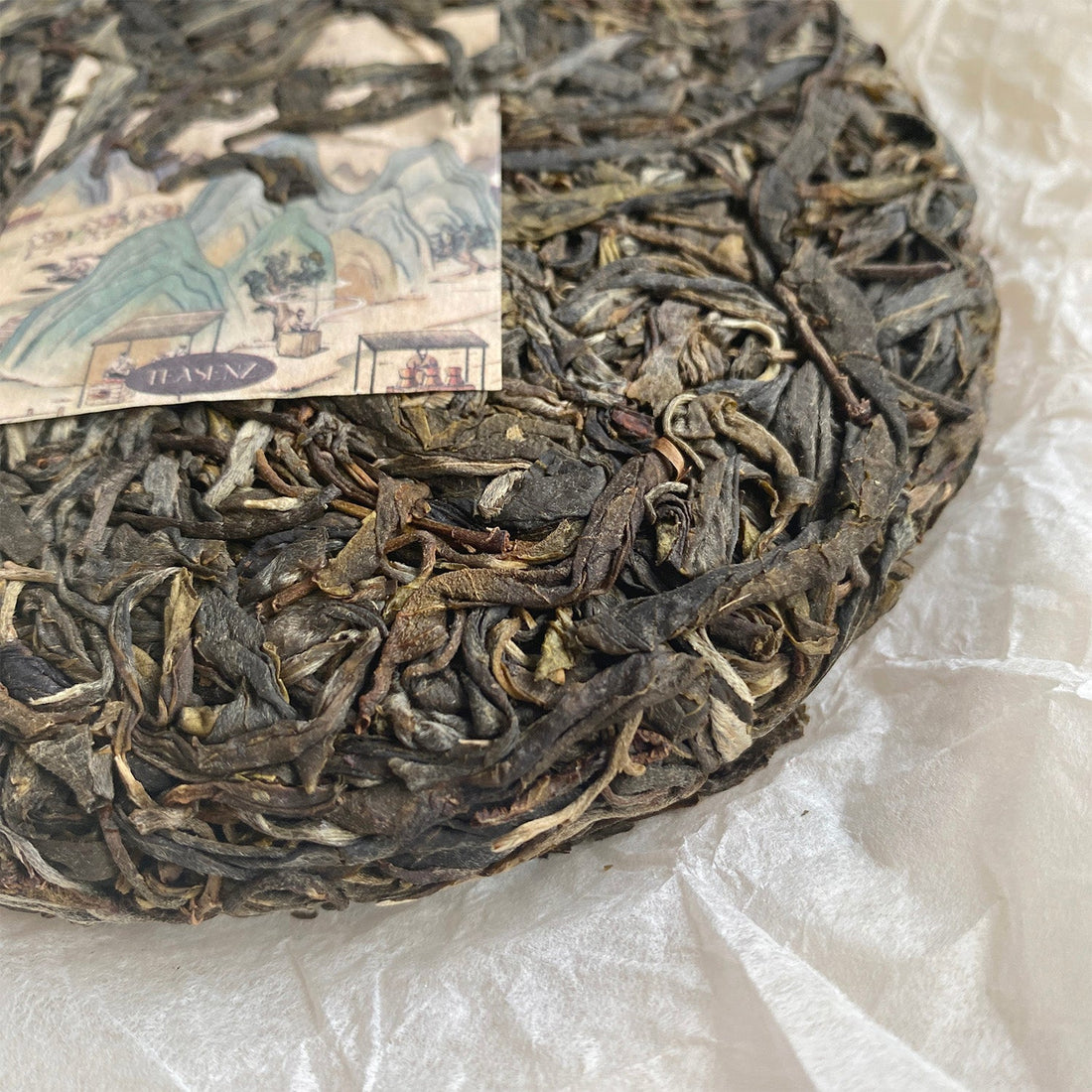Was genau ist Pu-Erh-Tee? Ein Leitfaden für Einsteiger

Teilen
Pu Erh (auch bekannt als „Puer“, „Bo Lay“ oder „Po Lei“) ist eine Teesorte, die aus der Teepflanze Camellia Sinensis hergestellt wird. Tatsächlich werden alle Teesorten, einschließlich Grüntee, weißer Schwarztee und Oolong-Tee, aus demselben Rohstoff hergestellt. Sie fragen sich vielleicht: Was unterscheidet Pu Erh von den anderen Arten?
Bei der Teeklassifizierung kommt es auf die verwendete Verarbeitungsmethode an. Daher wird ein Tee Pu Erh genannt, wenn für seine Herstellung eine der Pu Erh-Verarbeitungsmethoden verwendet wird.
Verarbeitung von Pu Erh Tee
Sha Qing, Fixieren & Sonnen & Trocknen
Wenn Pu-Erh-Tees gepflückt werden, werden sie auf einer Bambusmatte ausgebreitet, um zu trocknen und etwas Feuchtigkeit abzugeben. Nach einigen Stunden sind die Blätter welk und weich. Anschließend können sie in einem großen runden Wok geröstet werden, ein Vorgang, der auch als „Sha Qing“ oder „Kill Green“ bekannt ist. In der heutigen Zeit wird das Rösten teilweise auch in großen Maschinen durchgeführt. Der Zweck des Schüttelns besteht darin, den Welkprozess zu stoppen.
Während des Schüttelvorgangs kontrolliert der Teemeister die Temperatur und die Zeit, um einzigartige Aromen zu kreieren. Anschließend werden die gerösteten Blätter gerollt, um die Form zu „fixieren“ und den Geschmack zu intensivieren. Anschließend erfolgt die Trocknung in der Sonne, wodurch die Blätter den größten Teil ihrer verbleibenden Feuchtigkeit verlieren.
Mao Cha
Das Endprodukt dieses Prozesses ist loser roher Pu Erh-Tee, der auch als ‚Mao Cha‘ bekannt ist. Diese trockenen Blätter haben nur etwa 25% des Gewichts im Vergleich zu dem, wenn sie frisch gepflückt werden.
Mao-Cha-Blätter werden oft sortiert, bevor sie in verschiedene Formen gepresst oder lose verkauft werden. Vor allem die gelben Flocken („huang pian“) werden wegen ihres schlechten Aussehens oft entfernt. Sie werden daher aussortiert und separat verkauft.

Gereifter und roher Pu-Erh-Tee
Nach dem oben beschriebenen Produktionsprozess könnte der roher Pu Erh weich gedämpft und zu gepressten roher Teekuchen kuchen/Scheiben, schalenförmigen Touchas oder Ziegeln gepresst werden.
Das Pressen loser Blätter in feste Formen wurde in der Vergangenheit erfunden, um den Transport zu erleichtern. Menschen und Pferde transportierten Pu-Erh-Tee entlang der alten Teehandelsrouten in benachbarte Regionen, darunter Tibet. Obwohl der Transport heutzutage kein Problem mehr darstellt, werden komprimierte Tees aus Gründen der einfacheren Lagerung immer noch bevorzugt.

Während roher (sheng) pu erh hergestellt wird, indem lose mao cha direkt zu kuchen gepresst wird, gibt es eine andere Art von pu erh, die eine Nachfermentation vor der Kompression erfordert: reifer pu erh Tee. Diese Art von Tee ist auch bekannt als ‚shu‘ oder ‚shou‘ pu erh.
Haufengärung
Die Geschichte des reifen Pu Erh ist relativ kurz. Sie begann 1973, als die Kunming Tea Factory eine Methode erfand, um den Reifungsprozess von roher Pu Erh (Mao Cha) zu beschleunigen. Diese Methode, bekannt als ‚Pile-Fermentation‘ (Wo Dui), wurde schnell in der gesamten Branche umgesetzt, um der hohen Nachfrage nach Pu Erh gerecht zu werden.
In einer heißen, aber kontrollierten Umgebung stapeln die Teemeister Blätter bis zu einer Höhe von etwa 70 cm. Anschließend werden sie mit Wasser angefeuchtet und mit Leinentüchern abgedeckt. Dadurch bleibt der Mao Cha warm und feucht. Die Fermentationsgeschwindigkeit erhöht sich und die Blätter werden schnell braun. Sobald der gewünschte Fermentationsgrad erreicht ist, werden die nun reifen Pu-Erh-Blätter gewendet und zum Trocknen dünn ausgebreitet. Sie können jetzt in verschiedene reife Pu-Erh-Formen gepresst werden.

Beachten Sie, dass die Begriffe 'gereift' und 'roher' Pu Erh nichts mit dem Alterungsprozess zu tun haben. Sie sind lediglich Begriffe, um zwischen Pu Erh zu unterscheiden, der einer Haufenfermentation unterzogen wurde (gereift) oder nicht (roher). Sowohl gereifter als auch roher Pu Erh kann gelagert und gealtert werden.
Herkunft & Güteklassen
Pu-Erh-Tee wird hauptsächlich in verschiedenen Regionen der Provinz Yunnan in China hergestellt. Das Endprodukt könnte aus Blättern einer einzigen Herkunft oder aus einer Mischung von Blättern unterschiedlicher Herkunft hergestellt werden. Große Fabriken produzieren oft mehr Mischungen, um den Geschmack konsistent zu halten und große Produktionen zu ermöglichen, während kleine Produzenten häufiger auf Single-Origin-Produktionen setzen.
Die meisten Blätter werden in natürlichen Teegärten produziert, die von Teebauern bewirtschaftet werden. Für einige hochwertigere Tees werden die Blätter jedoch von wilden Laubbäumen gepflückt. Die älteren Wildbäume sind als „Gu Shu“ oder „alte Teebäume“ bekannt.
Wie wählt man den richtigen Pu-Erh-Tee aus?
Den Unterschied zwischen roher und reifem Pu Erh-Tee zu kennen, ist der erste Schritt bei der Auswahl, welchen Pu Erh-Tee man probieren möchte. Es gibt jedoch auch andere Faktoren, die wichtig sind, wie Herkunft, Teeblattgrad und Teemischungen im Vergleich zu Single-Origin-Tee. Darüber werden wir in unserem Artikel sprechen: Wie man den richtigen Pu Erh-Tee auswählt.
Wie man Pu-Erh-Tee zubereitet
Für die Zubereitung von Pu-Erh-Tee ist eine hohe und konstante Wassertemperatur erforderlich. Daher wird die Verwendung einer kleinen Yixing-Ton-Teekanne oder eines Gaiwan (Tasse mit Deckel) dringend empfohlen. Diese kleinen Gefäße ermöglichen auch das Aufbrühen kleiner Portionen Tee über mehrere Durchgänge hinweg. Eine großartige Möglichkeit, die vielen Geschmacksrichtungen zu genießen, die Pu-Erh-Tee so faszinierend machen. Lesen Sie unseren Leitfaden „ So brühen Sie Pu-Erh-Tee auf “, um alle Einzelheiten der Teezubereitung zu erfahren.
Nutzen für die Gesundheit
Für diejenigen, die Pu Erh genießen, gibt es glücklicherweise auch einige nette Nebeneffekte für die Gesundheit. Es enthält Koffein, das das zentrale Nervensystem, die Muskeln und das Herz stimuliert. Es enthält Antioxidantien, die das Herz und die Blutgefäße schützen können. Schließlich kann es der Alterung entgegenwirken, den Cholesterinspiegel senken und das Krebsrisiko verringern. Lesen Sie unseren vollständigen Leitfaden zu „ Gesundheitliche Vorteile und Nebenwirkungen von Pu Erh-Tee “.
